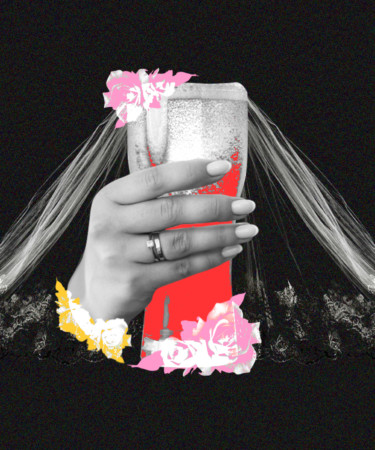Long before “Bridgerton” inspired bridal collections and gowns designed to be comfortable enough for wedding-day naps, brides in old England partook in trends and traditions of their own. Perhaps the most popular were wedding-day feasts and the pints of ale that accompanied them.
Marriage and merrymaking have long gone hand in hand. After all, you can’t say “bridal” without first giving a nod to “bride ale.” Yes, it’s true: The word used to describe a slew of “special day” topics related to a woman getting married (bridal party, bridal shower, bridal gown… you get the idea) comes from a centuries-old wedding drinking tradition.
The first documented use of the phrase “bride ale” appears in the Anglo-Saxon Chronicle, a written chronology of England’s early history published in 1075 A.D. This is approximately 125 years before bridal was adopted to describe something belonging to a bride or wedding.
To understand how the two words fit together and where the actual ale comes into play requires some linguistic sifting through historical accounts. (If an English lesson seems daunting, don’t worry: We promise it all comes back to beer.)
In the Anglo-Saxon period, circa 1000 A.D., people of England referred to their wedding feasts as “bredales.” Much like a modern-day wedding reception, these feasts were often boisterous and featured food, drinks, dancing, and gossip.
In the mid-11th century, bredale was overtaken by the more popular spelling, bride ale, referring to the post-wedding celebrations where beer was often served freely. The Anglo-Saxon Chronicle’s first documentation of a bride ale depicts a rowdy feast following the marriage of an English earl and his betrothed.
“There was that bride-ale, the source of man’s bale,” the text reads. Essentially, the writer was referring to a post-nuptial celebration — and the wedding ale that likely poured freely there — as destructive to the men who drank it. (Checks out.)
Bride ales, in liquid form, were so notoriously over-served at weddings that regulations were passed in parts of England to prevent brewers from making beers brewed specifically for weddings too strong.
Over time, bride ale began to take on multiple meanings in old English weddings. It was a common practice for a bride to brew her own beer for the wedding day. Again, modern parallels abound. Couples today often create their own specialty cocktails or brews for their big day. One British brewery even created a bride ale take of its own, brewing a unique beer for royal fans to drink on the wedding day of Prince Harry and Meghan Markle.
Many times, the bride ales of the olden days were served with a catch: Guests were expected to pay for the brews to help raise funds for the newlyweds’ home and items to buy (think: England’s version of an Amazon or Target registry back in the day). There are other stories of brides who served guests bride ale in exchange for receiving a gift on their wedding day. This model closely mirrors the practice of bridal showers, bachelorette parties, and wedding gift-giving today.
Out of this long trail of wedding day drinking traditions the term bridal eventually emerged in its contemporary form. Bridal, defined as “belonging to a bride or wedding,” was adapted, most etymologists agree, from bride ale. In this case, it is important to note, bride ale referred to the wedding celebration as a whole, not necessarily the beer that was served at these events. The word’s meaning expanded to encompass the full range of bride-related wedding events.
So, next time you’re raising a toast to the bride — no matter what’s in your cup — you’ll have beer to thank.
